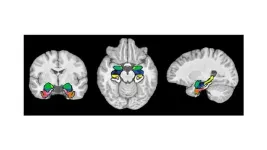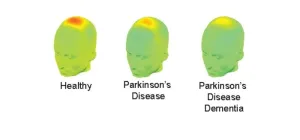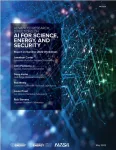(Press-News.org) In the film “Top Gun: Maverick,” Maverick, played by Tom Cruise, is charged with training young pilots to complete a seemingly impossible mission — to fly their jets deep into a rocky canyon, staying so low to the ground they cannot be detected by radar, then rapidly climb out of the canyon at an extreme angle, avoiding the rock walls. Spoiler alert: With Maverick’s help, these human pilots accomplish their mission.
A machine, on the other hand, would struggle to complete the same pulse-pounding task. To an autonomous aircraft, for instance, the most straightforward path toward the target is in conflict with what the machine needs to do to avoid colliding with the canyon walls or staying undetected. Many existing AI methods aren’t able to overcome this conflict, known as the stabilize-avoid problem, and would be unable to reach their goal safely.
MIT researchers have developed a new technique that can solve complex stabilize-avoid problems better than other methods. Their machine-learning approach matches or exceeds the safety of existing methods while providing a tenfold increase in stability, meaning the agent reaches and remains stable within its goal region.
In an experiment that would make Maverick proud, their technique effectively piloted a simulated jet aircraft through a narrow corridor without crashing into the ground.
“This has been a longstanding, challenging problem. A lot of people have looked at it but didn’t know how to handle such high-dimensional and complex dynamics,” says Chuchu Fan, the Wilson Assistant Professor of Aeronautics and Astronautics, a member of the Laboratory for Information and Decision Systems (LIDS), and senior author of a new paper on this technique.
Fan is joined by lead author Oswin So, a graduate student. The paper will be presented at the Robotics: Science and Systems conference.
The stabilize-avoid challenge
Many approaches tackle complex stabilize-avoid problems by simplifying the system so they can solve it with straightforward math, but the simplified results often don’t hold up to real-world dynamics.
More effective techniques use reinforcement learning, a machine-learning method where an agent learns by trial-and-error with a reward for behavior that gets it closer to a goal. But there are really two goals here — remain stable and avoid obstacles — and finding the right balance is tedious.
The MIT researchers broke the problem down into two steps. First, they reframe the stabilize-avoid problem as a constrained optimization problem. In this setup, solving the optimization enables the agent to reach and stabilize to its goal, meaning it stays within a certain region. By applying constraints, they ensure the agent avoids obstacles, So explains.
Then for the second step, they reformulate that constrained optimization problem into a mathematical representation known as the epigraph form and solve it using a deep reinforcement learning algorithm. The epigraph form lets them bypass the difficulties other methods face when using reinforcement learning.
“But deep reinforcement learning isn’t designed to solve the epigraph form of an optimization problem, so we couldn’t just plug it into our problem. We had to derive the mathematical expressions that work for our system. Once we had those new derivations, we combined them with some existing engineering tricks used by other methods,” So says.
No points for second place
To test their approach, they designed a number of control experiments with different initial conditions. For instance, in some simulations, the autonomous agent needs to reach and stay inside a goal region while making drastic maneuvers to avoid obstacles that are on a collision course with it.
When compared with several baselines, their approach was the only one that could stabilize all trajectories while maintaining safety. To push their method even further, they used it to fly a simulated jet aircraft in a scenario one might see in a “Top Gun” movie. The jet had to stabilize to a target near the ground while maintaining a very low altitude and staying within a narrow flight corridor.
This simulated jet model was open-sourced in 2018 and had been designed by flight control experts as a testing challenge. Could researchers create a scenario that their controller could not fly? But the model was so complicated it was difficult to work with, and it still couldn’t handle complex scenarios, Fan says.
The MIT researchers’ controller was able to prevent the jet from crashing or stalling while stabilizing to the goal far better than any of the baselines.
In the future, this technique could be a starting point for designing controllers for highly dynamic robots that must meet safety and stability requirements, like autonomous delivery drones. Or it could be implemented as part of larger system. Perhaps the algorithm is only activated when a car skids on a snowy road to help the driver safely navigate back to a stable trajectory.
Navigating extreme scenarios that a human wouldn’t be able to handle is where their approach really shines, So adds.
“We believe that a goal we should strive for as a field is to give reinforcement learning the safety and stability guarantees that we will need to provide us with assurance when we deploy these controllers on mission-critical systems. We think this is a promising first step toward achieving that goal,” he says.
Moving forward, the researchers want to enhance their technique so it is better able to take uncertainty into account when solving the optimization. They also want to investigate how well the algorithm works when deployed on hardware, since there will be mismatches between the dynamics of the model and those in the real world.
The work is funded, in part, by MIT Lincoln Laboratory under the Safety in Aerobatic Flight Regimes program.
###
Written by Adam Zewe, MIT News
Paper: “Solving Stabilize-Avoid Optimal Control via Epigraph Form and Deep Reinforcement Learning”
https://arxiv.org/pdf/2305.14154.pdf
END
A step toward safe and reliable autopilots for flying
A new AI-based approach for controlling autonomous robots satisfies the often-conflicting goals of safety and stability.
2023-06-12
ELSE PRESS RELEASES FROM THIS DATE:
Mass General Hospital researchers uncover why light-to-moderate drinking is tied to better heart health
2023-06-12
BOSTON – A new study led by investigators from Massachusetts General Hospital, a founding member of the Mass General Brigham healthcare system, offers an explanation for why light-to-moderate alcohol consumption may be associated with lower risk of heart disease. For the first time, researchers found that alcohol, in light to moderate quantities, was associated with long-term reductions in stress signaling in the brain. This impact on the brain’s stress systems appeared to significantly account for the reductions in cardiovascular events seen in light to moderate drinkers participating in the ...
NIH grant backs study focused on Alzheimer’s in women
2023-06-12
HOUSTON – (June 12, 2023) – Two-thirds of the people suffering from Alzheimer’s disease are women, yet most research has ignored differences between the sexes.
To help fill this gap, Rice University postdoctoral fellow Hannah Ballard will look at how Alzheimer’s risk, estrogen levels and menopausal status interact with memory-related brain function and behavioral outcomes in women age 35-80.
Supported by a three-year grant from the National Institutes of Health (NIH), Ballard’s research could help identify the physiological factors ...
Self-esteem of kids with short stature tied to social supports, not height
2023-06-12
Philadelphia, June 12, 2023—Challenging the assumption that short stature negatively impacts children and adolescents’ self-esteem, a new study by researchers at Children’s Hospital of Philadelphia (CHOP) has found that in otherwise healthy short youth, quality of life and self-esteem are associated with coping skills and how supported they feel and not the degree of their short stature. The findings were published in The Journal of Pediatrics.
“There is a notion among some parents and caregivers that short stature will negatively impact their children in terms of self-esteem and social adjustment, so they seek out growth hormone ...
Brain waves may predict cognitive impairment in Parkinson's disease
2023-06-12
A few minutes of data recorded from a single electrode placed on top of the head may be sufficient to predict thinking problems, including dementia, in patients with Parkinson’s disease (PD). The finding from a new University of Iowa study might help improve diagnosis of cognitive disability in PD and develop new biomarkers and targeted therapies for cognitive symptoms of the disease.
“Cognitive decline, including dementia, is a significant and underappreciated symptom of Parkinson’s disease. ...
The Face Game: A citizen science project to learn how Artificial Intelligence will choose to appear to humans
2023-06-12
Online, profile pictures of human faces are everywhere, and they play a crucial role in shaping the first impression we make on others. Right now, AI gives people the digital tools to transform their online appearance in any way they desire, often making themselves look younger or more attractive. But this is just the beginning: AI is not only helping us play this face game amongst ourselves, but it is also learning the game from us and quietly deciding which face it will showcase as itself when interacting with us.
To better understand these mechanisms, researchers from the Max Planck ...
Ethics & Human Research, May-June 2023
2023-06-12
Making an Advance Research Directive: An Interview Study with Adults Aged 55 and Older with Interests in Dementia Research
Nola M. Ries, Briony Johnston
Many people with dementia are interested in taking part in research, including when they no longer have capacity to provide informed consent. Advance research directives (ARD) enable people to document their wishes about research participation prior to becoming decisionally incapacitated. However, there are few available ARD resources. This Australian interview study elicited the views of people aged 55 years and older about the content of an ...
Visionary report unveils ambitious roadmap to harness the power of AI in scientific discovery
2023-06-12
Innovations in artificial intelligence (AI) are rapidly shaping our world, from virtual assistants and chatbots to self-driving cars and automated manufacturing. Seizing on the potential of AI to transform science, the nation’s leading experts in science and technology have released a blueprint for the United States to accelerate progress by expanding its capabilities in AI and big data analysis.
“AI for Science, Energy, and Security” lays out a comprehensive vision ...
Masai giraffes more endangered than previously thought
2023-06-12
UNIVERSITY PARK, Pa. — Giraffes in eastern Africa may be even more endangered than previously thought. A new study led by researchers at Penn State reveals that populations of Masai giraffes separated geographically by the Great Rift Valley have not interbred — or exchanged genetic material — in more than a thousand years, and in some cases hundreds of thousands of years. The researchers recommend that the two populations be considered separately for conservation purposes, with separate but coordinated conservation efforts to manage each population.
Populations of giraffes have declined rapidly in the last thirty years, with ...
WVU research shows how much pharmaceutical companies are capitalizing on rare drug incentives
2023-06-12
Drugs used to treat rare conditions are earning pharmaceutical companies almost as much as those marketed to the general public, according to a researcher at West Virginia University. Sean Tu, a College of Law professor found lucrative so-called “orphan” drugs earn manufacturing tax credits, have longer patent exclusivities and face easier Food and Drug Administration review.
Orphan drugs treat diseases that affect fewer than 200,000 Americans. In addition to tax credits, Congress has incentivized the pharmaceutical companies that manufacture orphan drugs with a waiver of ...
Planet orbiting 2 stars discovered using new technique
2023-06-12
COLUMBUS, Ohio – An international team of astronomers is the first to apply an old technique to discover a new type of planet that orbits two stars – what is known as a circumbinary planet.
As an added bonus, researchers found a second planet that is orbiting the same two stars, which is only the second confirmed multi-planet circumbinary system found to date. The study was published today in the journal Nature Astronomy.
Circumbinary planets were once relegated to only science fiction, but thanks to data collected from NASA’s Kepler mission, astronomers now know that multiple star systems are ...
LAST 30 PRESS RELEASES:
Rice establishes Global Brain Economy Initiative in Davos, aligned with new report on brain health and AI
Quantum error correction with logical qubits
Nutrient-stimulated hormone-based therapies: A new frontier in the prevention and management of MASH-associated hepatocellular carcinoma
Trauma or toxic? A deep dive into the impact of stress on kids' health
Turning industrial exhaust into useful materials with a new electrode
ORNL to partner with Type One Energy, UT on world-class facility to validate next-gen fusion
New journal section tackles AI, ethics, and digital health communication
Jeonbuk National University researchers develop novel dual-chemical looping method for efficient ammonia synthesis
New study sheds light on stroke recovery via exercise-induced migration of mitochondria
SEOULTECH researchers develop sodium-based next-generation smart electrochromic windows
Data-driven analysis reveals three archetypes of armed conflicts
Heart disease, stroke deaths down, yet still kill more in US than any other cause
Light switches made of ultra-thin semiconductor layers
Creative talent: has AI knocked humans out?
Sculpting complex, 3D nanostructures with a focused ion beam
A year after undermining Bredt’s rule, UCLA scientists have made cage-shaped, double-bonded molecules that defy expectations
Human activities drive global dryland greening
PeroCycle announces new appointments as it builds a world-class board for meaningful climate impact
Magnetic avalanches power solar flares
LeapSpace goes live: the Research-Grade AI-Assisted Workspace built on trusted science
DNA tests reveal mysterious beluga family trees
Strategic sex: Alaska’s beluga whales swap mates for long-term survival
How early cell membranes may have shaped the origins of life
Cannabis legalization is driving increases in marijuana use among U.S. adults with historically lower consumption rates
Multifunctional dipoles enabling enhanced ionic and electronic transport for high‑energy batteries
Triboelectric nanogenerators for future space missions
Advancing energy development with MBene: Chemical mechanism, AI, and applications in energy storage and harvesting
Heteroatom‑coordinated Fe–N4 catalysts for enhanced oxygen reduction in alkaline seawater zinc‑air batteries
Meta-device for precision lateral displacement sensing
Plasma-guided mitotane for the treatment of adrenocortical carcinoma: adjuvant care to advanced disease
[Press-News.org] A step toward safe and reliable autopilots for flyingA new AI-based approach for controlling autonomous robots satisfies the often-conflicting goals of safety and stability.





